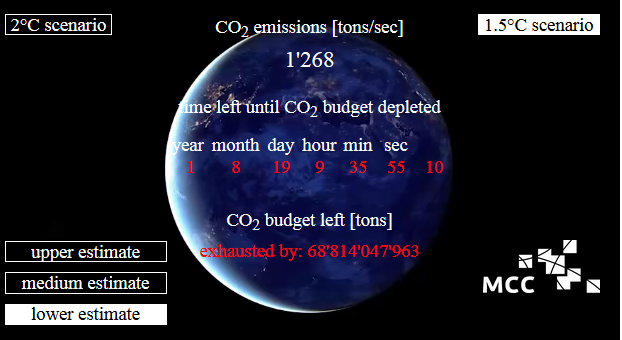The Mercator Group has an online countdown clock based upon the IPCC, Climate Change 2014: Mitigation of Climate Change. Contribution of Working Group III to the Fifth Assessment Report of the Intergovernmental Panel on Climate Change.
The top left of the clock you can select, for reaching the 2°C target, an optimistic upper estimate (about 940 Gt¹ remain in the budget), a medium estimate (about 760 Gt² remain), or a pessimistic lower scenario (about 390 Gt¹ remain). The right of the screen shows the scenarios that would correspond to the 1.5°C target. The calculation is based on the assumption that annual emissions remain at the level of 2014; while between 2000 and 2010, an annual growth of greenhouse gas emissions of 2.2% has been observed.
Based on the IPCC 2014 and the countdown clock we had already run out of time on the 1.5C warming low probability and next year the the 1.5C medium probability clock would have run out.


Re-estimating the remaining carbon budget

This was cutoff as feature image. The amount of CO2 emissions at 40 billion tons per year out to 2100 shows warming at about 1.7 degrees. 0.2 degrees was added with shift from 30 billion tons per year to 40 billion. It takes more CO2 to force up the same level of temperature increase. CO2 is logarithmically correlated to temperature increase. So If 40 billion tons per year is 1.7 degrees then to get the next 0.3 degrees would probably be about 70-90 billion tons per year out to 2100.

In their paper, they ask a different question of these ESMs, namely what is the cumulative CO2 emissions budget, from today onwards, compatible with levels of simulated warming on top of the model’s present warming?
In other words, if human-caused warming over this decade was – on average – about 0.9C, a budget for 1.5C above preindustrial corresponds would correspond to a budget for 0.6C more human-caused warming from this decade on.
We investigated what ESMs can tell us about such budgets. This approach allows us to examine what the models say about future warming relative to future emissions, without bringing in any potential model bias simulated over the historical period.
This method gives an estimate for the remaining 0.6C of warming of about 880bn tonnes of CO2, from the beginning of 2015. This is about equal to about 20 years at current annual emissions, or alternatively, a straight line decrease in CO2 emissions from today’s values to zero in about 40 years.
They construct pathways in which emissions are continually adapted over time in order to actually achieve a warming of 1.5C in 2100 no matter what the climate response turns out to be. This mimics an adaptive climate policy under the Paris Agreement’s pledge-and-review system – and assumes it’s successful.
Estimated in this way, we find the remaining carbon budget for a 66% probability of limiting warming to 1.5C in 2100 is 915bn tonnes of CO2 (from the start of 2015). This number is consistent with our ESM estimates given earlier, and again assumes very aggressive action to reduce non-CO2 contributions to warming.
Old Upper limit on 2 degree warming has become the lower or middle limit for 1.5 degree warming

I think it also means that just hold steady on emissions would mean no 2 degree warming this century.

Brian Wang is a Futurist Thought Leader and a popular Science blogger with 1 million readers per month. His blog Nextbigfuture.com is ranked #1 Science News Blog. It covers many disruptive technology and trends including Space, Robotics, Artificial Intelligence, Medicine, Anti-aging Biotechnology, and Nanotechnology.
Known for identifying cutting edge technologies, he is currently a Co-Founder of a startup and fundraiser for high potential early-stage companies. He is the Head of Research for Allocations for deep technology investments and an Angel Investor at Space Angels.
A frequent speaker at corporations, he has been a TEDx speaker, a Singularity University speaker and guest at numerous interviews for radio and podcasts. He is open to public speaking and advising engagements.

